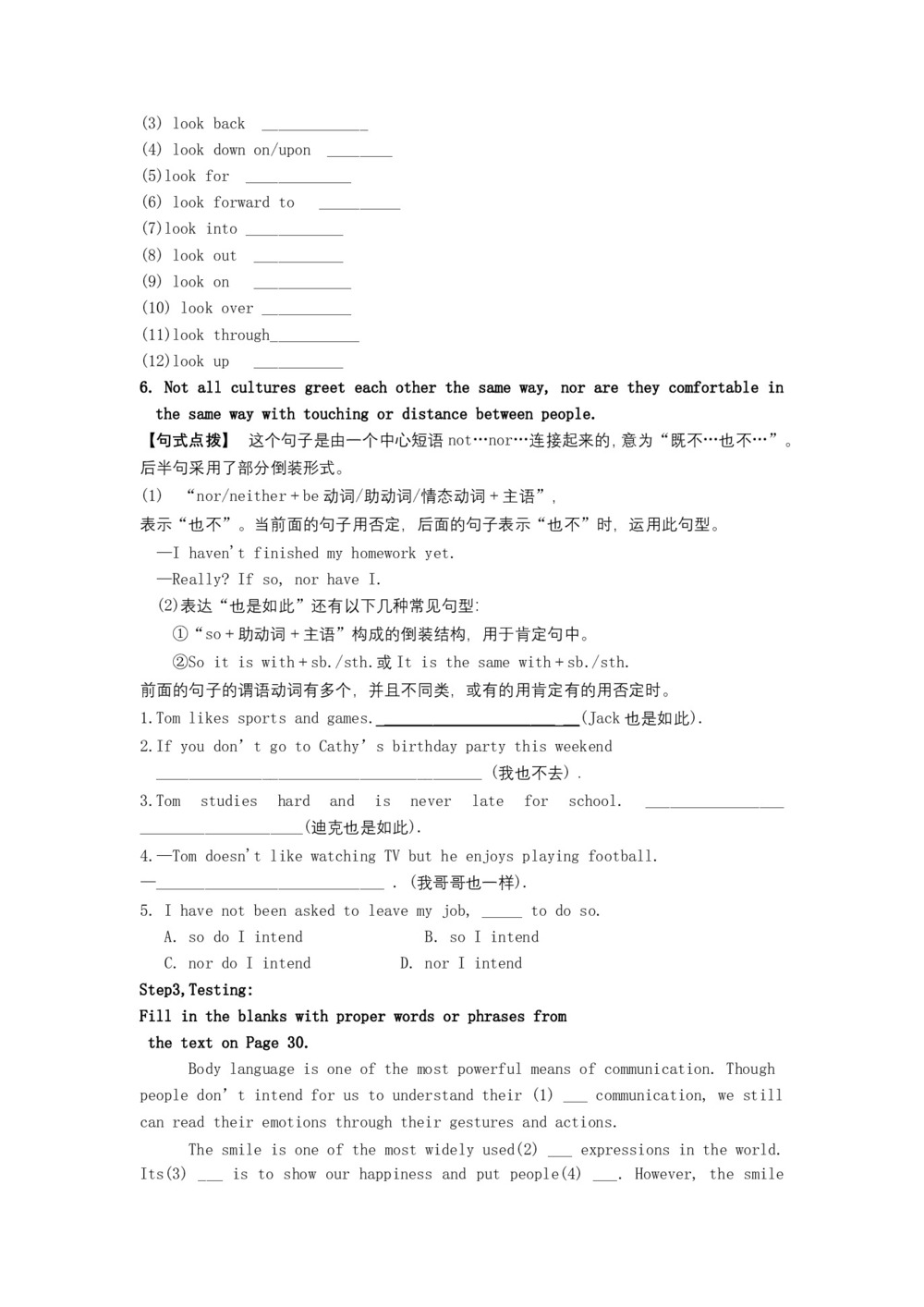
(3) look back _____________
(4) look down on/upon ________
(5)look for _____________
(6) look forward to __________
(7)look into ____________
(8) look out ___________
(9) look on ____________
(10) look over ___________
(11)look through___________
(12)look up ___________
6. Not all cultures greet each other the same way, nor are they comfortable in the same way with touching or distance between people.
【句式点拨】 这个句子是由一个中心短语not...nor...连接起来的,意为"既不...也不..."。后半句采用了部分倒装形式。
(1) "nor/neither+be动词/助动词/情态动词+主语",
表示"也不"。当前面的句子用否定,后面的句子表示"也不"时,运用此句型。
-I haven't finished my homework yet.
-Really? If so, nor have I.
(2)表达"也是如此"还有以下几种常见句型:
①"so+助动词+主语"构成的倒装结构,用于肯定句中。
②So it is with+sb./sth.或It is the same with+sb./sth.
前面的句子的谓语动词有多个,并且不同类,或有的用肯定有的用否定时。
1.Tom likes sports and games. _____________________ __(Jack也是如此).
2.If you don't go to Cathy's birthday party this weekend
________________________________________ (我也不去).
3.Tom studies hard and is never late for school. _________________ ____________________(迪克也是如此).
4.-Tom doesn't like watching TV but he enjoys playing football.
-____________________________ . (我哥哥也一样).
5. I have not been asked to leave my job, _____ to do so.
A. so do I intend B. so I intend
C. nor do I intend D. nor I intend
Step3,Testing:
Fill in the blanks with proper words or phrases from
the text on Page 30.
Body language is one of the most powerful means of communication. Though people don't intend for us to understand their (1) ___ communication, we still can read their emotions through their gestures and actions.
The smile is one of the most widely used(2) ___ expressions in the world. Its(3) ___ is to show our happiness and put people(4) ___. However, the smile does not always mean that we are (5)___ happy. Smiles can be (6)___ sometimes, hiding other feelings
-
相关教案下载
- 1【互动课堂】2018-2019学年人教版高中英语必修四学案设计:Unit4《Body Language》Reading
- 2【互动课堂】2018-2019学年人教版高中英语必修四学案设计:Unit4《Body Language》语法
- 3【互动课堂】2018-2019学年人教版高中英语必修四学案设计:Unit4《Body Language》Reading阅读
- 4【互动课堂】2018-2019学年人教版高中英语必修四学案设计:Unit4《Body Language》复习巩固
- 52018-2019学年人教版高一英语必修4学案之 互动课堂 :Unit4 Body language
- 6【学道】2018-2019学年人教版高中英语必修四学案设计:课堂导学Unit4 Body language Word版含解析
- 7【互动课堂】2018-2019学年人教版高中英语必修四学案设计:Unit3《A taste of English humour》词汇
- 8【学道】2018-2019学年人教版高中英语必修四学案设计:课堂探究Unit4 Body language—SectionⅠWord版含解析
- 9【互动课堂】2018-2019学年人教版高中英语必修四学案设计:Unit5《Theme parks》Period 4 Using Language